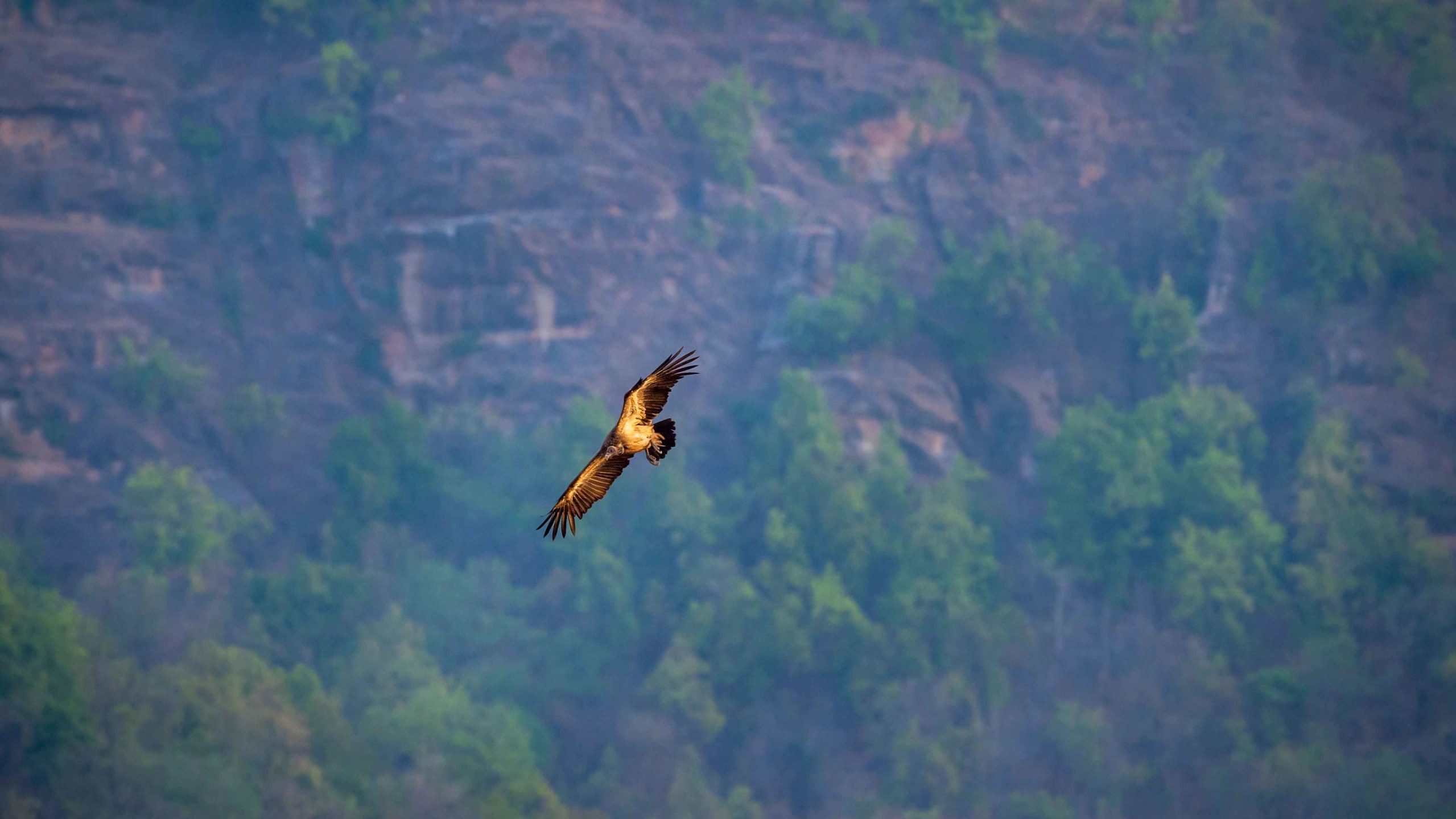 Listen to this article
•
15:34 min
Listen to this article
•
15:34 min
About a month ago, around two dozen vultures in Panna Tiger Reserve (PTR) were tagged with GPS devices as part of a scientific exercise to monitor vulture movement for understanding the behaviour of the species in the protected area of Madhya Pradesh. “We have tagged 25 vultures so far –13 Indian vultures, 8 Himalayan griffon vultures, 2 Eurasian griffon vultures and 2 king vultures,” Ramesh Krishnamurthy, scientist, Wildlife Institute of India (WII) told Mongabay-India. “These vultures were captured based on different methods that included walk-in enclosure, leg-hold trap and clap trap. These were well established traditional methods that have proved successful across country for tagging several migratory birds including vultures,” he said. Among the vultures tagged, the Indian vulture (Gyps indicus) is a critically endangered species.
The vulture tagging was carried out by a team, including veterinarians from Wildlife Institute of India under the Landscape Management Plan project, supported by professional trappers, resident veterinary officers and park officials of PTR during the winters of 2020-2021 and 2021-2022. The process involved multiple stages such as preparation, capturing, tagging, measuring and releasing. Every day, the team would reach the field well before sunrise, set up traps and wait for the birds, Krishnamurthy said, adding that, “Sometimes vultures come to the trap station but on other occasions they would not.” Eventually, they managed to capture the birds and they had to be handled carefully, owing to their size and fragility.
Among the challenges encountered by the team was this —the baiting stations that they set up for the vultures invited other wildlife, including tigers, which in turn deterred the vultures that took a longer time to come to the bait, explained Krishnamurthy.
Finally, the captured vultures were tagged with sophisticated GPS tags, known as e-ObsTags. The tags, manufactured in Germany, are solar-powered and weigh between 25 g and 75 g, which is quite light in weight compared to the birds that weigh over 12 kg, an official said.
The tags were configured to collect and store data and then transmit the data whenever they come in transmission link, Krishnamurthy said. He added, “It is a GSM-based tag and data is transmitted when the birds take flight and soar. Moreover, it collects data at every five minutes, allowing fine scale data along with elevation, temperature and activity."
Because the tagging involved both resident and migratory vultures, the movement data will allow the wildlife conservationists to observe the places where the vultures go for feeding and roosting. This information in turn helps the team plan conservation and protection interventions in the locations where the vultures face threats.
The GPS tags act like smartwatches that humans use in their daily routine such as jogging and exercise, explained Dibyendu Biswas, WII’s Junior Research Fellow while speaking to Mongabay-India. The way the smartwatches informs us how long we have run, steps taken by us etc., similarly the GPS tags provide information about the vulture behaviour, he said.
Vulture tagging will help the wildlife conservationists to get detailed information about the movement, daily behaviour such as the way the vultures drink water and interact with each other, their adaptability to a new area and how they secure such new areas of their movement. These details will help develop further understanding about the conservation of the species that provide invaluable ecosystem services by enhancing the flow of nutrients within food webs and reducing transmission of infectious disease through the removal of carrion.

According to Uttam Kumar Sharma, Director, Panna National Park (PNP), “Madhya Pradesh has got good results in the conservation of vulture species. The number of vultures (in the state) has increased to 9,446 in the year 2021.” Nine species of vultures are found in India, of which three are critically endangered and seven of the total species are found in PNP, a press release from the park noted. Among the ones found in PNP, are migratory species such as Himalayan griffon vulture, Eurasian griffon vulture and Cinereous vulture as well as resident species such as Indian vulture, white-rumped vulture, red-headed vulture and Egyptian vulture.
Since the catastrophic decline of vultures over the end of the last century, telemetry-based research has become imperative for understanding movement patterns of these birds. This includes migration, foraging, roosting, nesting, bathing and other behaviours, understanding all of which is critical for their conservation, specifically when these birds require large area for survival including human spaces and carcass dumps. The current scientific literature shows that 14 vulture species have been tagged and studied across 24 countries, but none from India.
The current study will establish a baseline data of these activities across a spatiotemporal scale. Furthermore, hematological, and microbiological analysis from the obtained samples will help determine the overall health status of the individuals and to a certain extent, about the health of vulture populations in and around the reserve. All findings from the current study will lead to significant policy implications, in providing answers to existing knowledge gaps, and towards adaptive management of these raptors in the Greater Panna Landscape.
This story first appeared in Mongabay India.






